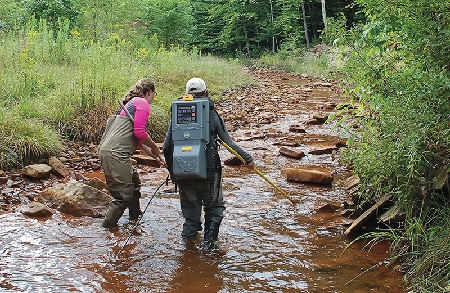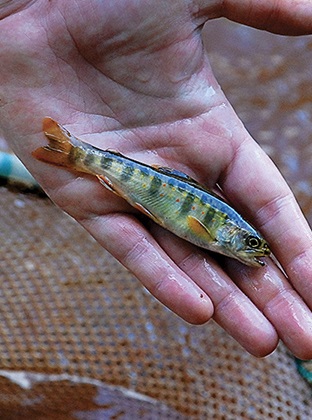 In the words of one scientist, the water of Bilger Run, about 20 miles east of Pennsylvania’s famous town of Punxsutawney, “looks like Tang.” Yes, Tang, the powdered orange drink that was available to, if not enjoyed by, U.S. astronauts of the 1960s.
In the words of one scientist, the water of Bilger Run, about 20 miles east of Pennsylvania’s famous town of Punxsutawney, “looks like Tang.” Yes, Tang, the powdered orange drink that was available to, if not enjoyed by, U.S. astronauts of the 1960s.
“No one would think there are fish in there,” said Tom Clark, author of the Tang comparison and an acid mine drainage specialist for the Susquehanna River Basin Commission.
But there are fish in there. There are, in fact, native brook trout in there, considerably more of them than of their nemesis, the larger and somewhat hardier European brown trout. Fish counts this summer have shown that the discolored stream has roughly nine “brookies” for every brown trout — a species introduced to the Eastern United States in the late 19th century, when the native trout seemed to be succumbing to overfishing and habitat degradation.
In contrast, in nearby Kratzer Run, which meets Bilger near Curwensville, on its way to the West Branch of the Susquehanna, the water is quite clear — and the survey numbers are the other way around: a preponderance of brown trout by nearly four to one.
Brookies surviving in Tang-colored water may come as a shock to laymen and even fly-fishing enthusiasts, who know the native trout as a sort of poster child for freshwater stream health. But scientists are not surprised. It’s well-documented that brook trout have a higher acid tolerance than brownies do. And Bilger Run’s acidity is low enough for brook trout to survive and high enough to keep the browns out.
It is not lost on the researchers for whom, at least in this case, fixing the stream’s acid problem will mean trouble for the brook trout. “While everyone can agree that [acid remediation] is a good thing,” said Brianna Hutchinson, an aquatic biologist with the river commission, “our expectation is that it is not going to be good for the brook trout.”
Acidity, or low pH, is caused by acid mine drainage, a widespread problem in Appalachian coal country as surface and shallow groundwater is turned highly acidic by contact with coal mining waste. When the polluted water makes its way into a stream, it lowers pH levels and elevates metals, particularly iron and aluminum which are harmful to fish, as well as the insects that sustain them. Two centuries of coal mining contaminated thousands of miles of Pennsylvania streams, with nearly 2,000 miles in the Susquehanna basin classified by the state in 2012 as impaired by acid mine drainage.
 The river commission is in the early stages of a project, funded by a $300,000 federal grant, to remediate acid mine pollution in the Bilger watershed. And fisheries scientists have pounced on it as a perfect opportunity to monitor the two trout species and measure the territorial effects of the remediation, both during and after.
The river commission is in the early stages of a project, funded by a $300,000 federal grant, to remediate acid mine pollution in the Bilger watershed. And fisheries scientists have pounced on it as a perfect opportunity to monitor the two trout species and measure the territorial effects of the remediation, both during and after.
“We are looking at what happens when we [correct] the low pH,” said Hutchinson, who is leading the trout project. Also taking part in the study are fishery specialists from Trout Unlimited, Indiana University of Pennsylvania and other institutions.
“We want to see at what point during the remediation do the browns start moving in [and] what will happen to the brook trout,” Hutchinson said. “Do they move into tributaries? Are they eaten?”
Generally speaking, according to Jennifer Graves, a graduate student from Indiana University of Pennsylvania who has been surveying and tagging the trout since July, the brown trout tend to drive the natives away. “When brooks and browns live in the same stream,” she said, “[the browns] will push the brooks up to the upstream limits.”
Shawn Rummel, a Trout Unlimited ecologist working on restoring coldwater fish habitat, said the study is needed.
“There hasn’t been this kind of work before in Pennsylvania that measures the biological impact of restoration,” he said. “Success is traditionally measured in the amount of metals removed from the water. Because the brown trout are there, it’s a unique way to study all of those interactions.”
Land reclamation — the permanent removal of mine waste — is considered the ideal solution to acid drainage, but it’s often not practical and doesn’t alway solve all of the water impairment issues. The Bilger Run project will use another method, limestone treatment cells. This method uses limestone placed in ground pits dug in the path of the mine drainage before it hits the stream. The limestone corrects the pH of the drainage, then feeds it to a wetland where the metals fall out before it flows back into a stream.
Along Kratzer Run, a fish the scientists called “Rick” lay on the operating table, a wooden cradle set up on a stream bank. A large brown trout, he took up most of the cradle’s 18-inch length. IUP’s Graves adeptly made a tiny incision in the abdominal flesh of the anesthetized patient and inserted a radio device with a long antenna hanging from his side. After the roughly four-minute procedure, the fish was returned to the water.
Rick and about 25 other large brownies all received a radio transmitter that will help Graves track the larger fish during spawning season. She wants to see how far upstream they travel to breed.
Meanwhile, some 300 smaller fish, both brownies and brookies, have been fitted with a tiny barrel-shaped passive integrated transponder, or “PIT tag.” Not unlike an EZPass, the transponder puts out a signal that is picked up by tag readers suspended above the streams — which record each fish’s individual data.
Five “toll roads” have been set up, each with transponder readers near known acid mine drainage sources. The researchers want to see if fish stay within their chemical comfort zones or venture out. The stream is monitored constantly within each section for changes in water chemistry, temperature and turbidity.
“The stations are placed strategically to see if [acid] discharges are acting as a chemical barrier to brown trout,” Graves said. “They’re also there to track how both species move across varying degrees of acid [pollution] and to record the invasion of brown trout.”
Researchers hope that the results of the Bilger/Kratzer study will provide enough evidence to inform government agencies and fishing clubs on future stocking programs — as well as offer suggestions for managing trout populations during acid drainage remediation.
If the study ultimately shows that acid remediation does clearly favor brown trout, champions of the native brookie may have to rethink their approach to stream cleanup. The Chesapeake Bay Program’s brook trout management strategy, for instance, sees both acid mine drainage and brown trout competition as major obstacles to recovery of the native fish. Yet success in the former could mean failure in the latter — at least in cases where brown trout exist nearby or could move in from another stream. The Bay Program’s goal is to achieve at least an 8 percent increase in occupied habitat by 2025. The initiative began in 2014 but there’s not enough data to know if there’s been progress toward that goal.
The fact that researchers found fish at all in the two streams is indicative of some improvement in water chemistry, said the river commission’s Clark. “There were no fish in Kratzer until five or 10 years ago,” he said. “Most likely, some guy threw [some] brown trout in there and said, ‘Let’s see if fish will survive there.’ And they did, and now they’re reproducing.”
Kratzer Run’s clear water, he points out, does not mean it’s unimpaired. Few bugs exist there to feed the big browns, Clark said. The fish are most likely eating each other and terrestrial bugs. But they are surviving — reproducing — and some are moving up to the mouth of Bilger.
Both stream runs are listed as impaired by the Pennsylvania Department of Environmental Protection — though, ironically, the state Fish and Boat Commission lists Kratzer Run as a Class A wild trout fishery, a designation that means fish are reproducing naturally and no stocking will be allowed.
What really makes Bilger special, Clark explained, is that aside from pH imbalance, it is great for trout. The stream runs cold, with forested banks and little development. The fact that browns will likely take over once the acidity is removed is sad, he said, but there is no way of stopping them—and leaving the stream alone is not an option. Low pH affects aquatic insects and other elements of the food web in a stream, not just the fish that swim there.
“Our concern here is that we have got to restore the streams — we have to get the iron out,” he added.
Meanwhile, the researchers hope the study will encourage fisheries managers and private fishing clubs and citizens to be more careful when stocking streams.
“What’s going to come out of this is a warning,” Clark said. “It’s a cautionary tale. It’s great those streams [have fish again] — but don’t put brown trout in them without knowing what is upstream. There are streams out there that have brook trout in them.”
